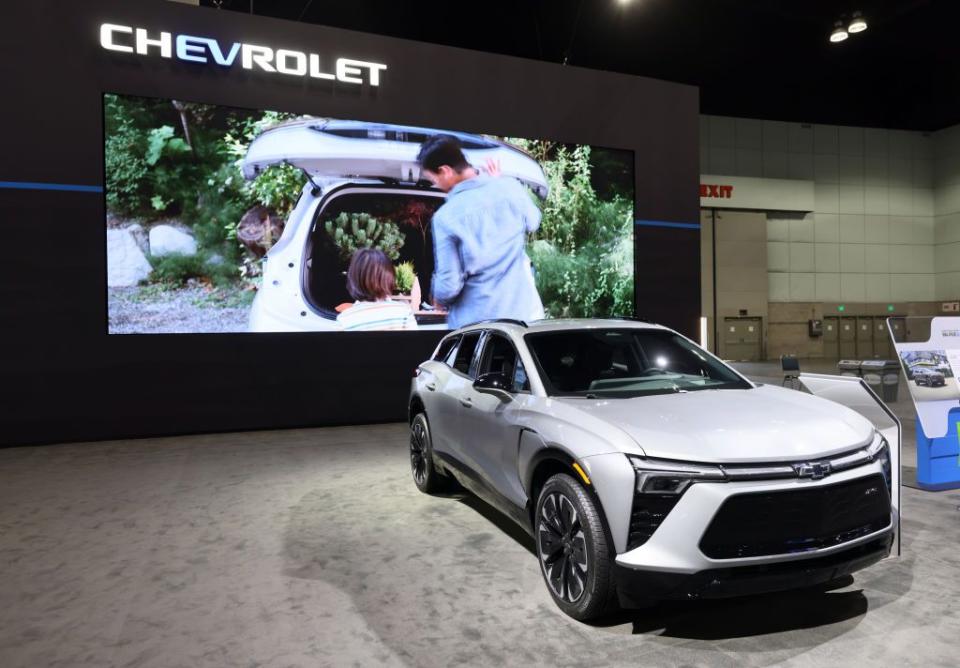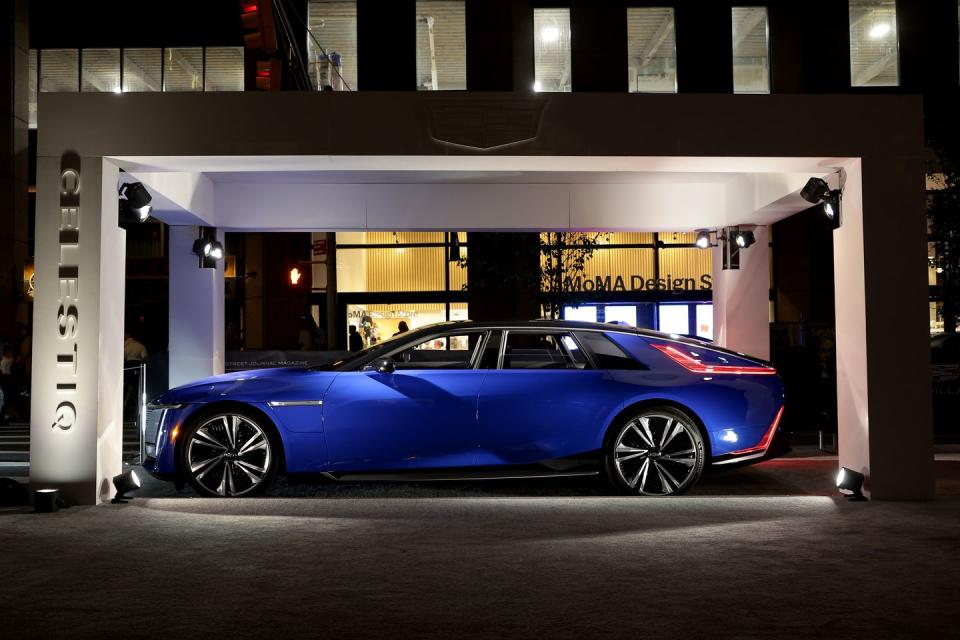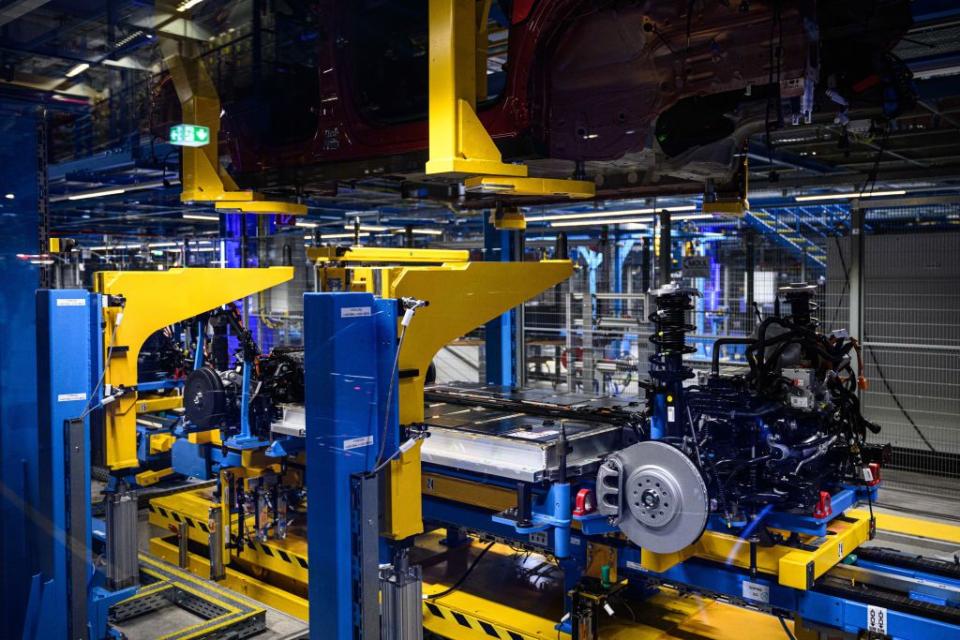EVs Are Holding Their Own

"Hearst Magazines and Yahoo may earn commission or revenue on some items through these links."
Remember a few months ago, when unsold EVs were supposedly “piling up” on dealer lots? This widely misconstrued inventory news sparked a familiar wah-wah chorus from EV Cassandras, with dire predictions that Americans were suddenly rejecting EVs. A run on used Hummers couldn’t be far behind.
Yes, EVs are hitting serious speed bumps, as you’d expect with any new technology that’s trying to unseat an incumbent with 137 years of history behind it. But as we steam into 2024, the latest round of plug-in denialism recalls Yogi Berra’s famously cockeyed advice: “Nobody goes there anymore. It’s too crowded.”
Well, if nobody wants EVs, those showrooms seem awfully crowded. For the first time in history, Americans bought more than 1 million EVs in 2023. That milestone was crossed in November, with final sales estimates approaching 1.2 million, according to Kelley Blue Book. That’s a healthy 52-percent gain over 2022, versus a mere 7-percent gain for ICE models. Yes, EV growth slowed from annual 90-percent increases that EVs had been posting. But no one realistically expected that smoking pace to continue forever; least of all when soaring interest rates are making all new cars a painful stretch for many would-be buyers.
Still, EVs are now capturing a record 7.6-percent share of the U.S. new-car market, up from 5.9 percent in 2022. And EV growth here is actually outpacing that of EVs in Europe.
Despite that, Ford, GM and even Elon Musk are sounding cautionary notes and rejiggering electric plans. Lucid and Polestar fell short of yearly production targets. GM CEO Mary Barra spoke of “moderating” (read: slowing) the acceleration of EV production in North America. Musk said he was “worried about the high interest-rate environment” we’re in.
“I just can’t emphasize enough how important cost is,” Musk said. “We have to make our products more affordable so people can buy them.”
Tesla already dramatically slashed prices on most models, forcing Ford, Lucid and some others to follow suit. Yet Tesla continues to generate profits that are the envy of the global industry — yes, higher net profits than legacy makers are generating with ICE cars — proving it can be done. Whether the likes of Ford and GM can do it remains an open question.

Consider GM’s bewildering struggle, as a purported master of mass production, to make enough Ultium batteries to build Cadillac Lyriqs or Hummer EVs in meaningful numbers. The latest snafu is a production halt for the 2024 Chevy Blazer EV to deal with software malfunction. For these all-new, highly touted models, these are potentially momentum-killing missteps. But those are failures of execution by GM, not an indictment of EV technology itself.

Ford is easing back on F-150 Lightning production to boost F-150 Hybrid output by 20 percent. The automaker pressed the pause button on $12 billion in EV projects, and CEO Jim Farley told us why on a company earnings call. An earnings report argued that EV buyers “were unwilling to pay premiums” for EVs versus gasoline or hybrid vehicles.
“A great product is not enough in the EV business anymore. We have to be totally competitive on cost,” Farley said.
Farley is right on products and price. But I don’t believe they’re entirely right about EV premiums — as long as those premiums feel reasonable for what you’re getting. The F-150 Lightning and Mustang Mach-e are both products Ford can be proud of. The Lightning actually sold a monthly-record 4,393 units in November. Ford moved 8,958 EVs overall in November, another record, and a 43-percent jump from a year ago. The Lightning topped the Rivian R1T as America’s best-selling electric truck, and Ford sold more Lightnings in one month than it had in the entire third quarter, because of a painful pause to retool its EV plant. Again, the issue appears execution, not evidence that people won’t buy an EV that’s right for them.

Is it any surprise that Ford has had some trouble pushing top-shelf Lightning Platinums that started from $100,000, prior to a $6,000 price cut? And every penny that GM and Barra frittered away on a six-figure, 4.5-ton albatross known as the Hummer EV — including Super Bowl ads with a well-compensated LeBron James — might have been spent on speeding affordable models like the Chevy Equinox and Blazer EVs into showrooms. Models that could battle Tesla head on, including on price. Don’t get me started on the $300,000 Cadillac Celestiq.

Here’s another stat to marvel at: More than one in three luxury sales is now a pure EV, according to Wards Intelligence. And they’re not all Teslas. Rivian sales jumped 126 percent in the third quarter, versus the same period in 2022, to more than 15,000 units.
The top-heavy, luxury-centric EV market is a definite concern, as exemplified by consumers suddenly rediscovering hybrids, including from their perennial champion Toyota. Throw in hybrids and PHEVs — the easiest antidotes to range and charging anxiety — and electrified models grabbed a record 17.7 percent of the market in the third quarter, according to the U.S. Energy Information Administration. In other words, nearly one in five new cars is electrified in some form. That’s more than double the market share of electrified models from just two years ago. That hybrid tech is finding ardent champions at the highest reaches of enthusiast cars, including Ferrari, McLaren, Lamborghini and Corvette’s new e-Ray. Once again, only one powertrain choice continued to lose market share in 2023, and that’s non-hybrid ICE cars.
Take away luxury models — that is, if you consider a Model 3 a luxury car — and EVs are only holding 2 percent of the overall market. But some mainstream brands are coming on strong.
Hyundai Motor Group sold 28,556 EVs in the third quarter between its Hyundai, Kia and Genesis brands, more than any automaker save Tesla. Those sales easily topped Ford’s 20,692 units, GM’s 20,092 and Volkswagen Group’s 20,205. And somehow, Hyundai managed this despite being totally shut out of $7,500 consumer credits, due to the Inflation Reduction Act that now requires companies to build its EVs in North America, and source batteries and minerals from North America or its trade partners. So much for the idea that customers won’t pay a premium for the right EV. Models like the Hyundai Ioniq5 and Ioniq6, Kia EV6 and three-row EV9, and Genesis GV70 Electrified, have married award-winning design, performance, efficiency and ultra-fast charging, and are reaping the rewards. Where Ford and GM seem to be having some second thoughts, Hyundai is building a loyal following, while working to scale up and bring prices down.
"We do not plan to dramatically reduce EV production or our lineup due to likely near-term hurdles as we believe EV sales will grow longer term," Seo Gang Hyun, a Hyundai executive vice president, told analysts.

While I was writing this, a Hyundai Ioniq6 press car coincidentally arrived at my house. It’s another mainstream winner, with a starting price just over $38,000, a combined 103 mpge rating, and a typical $700 annual energy bill versus $1,600 for the average gasoline-powered new car — meaning the Ioniq6 will steadily pay back any price premium. It’s also a stylish, smart-driving sedan, a segment that Detroit has turned its back on, again after years of insisting these cars can’t possibly compete or turn a profit.
I don’t mean to minimize the massive challenges EVs face, including the shabby state of public charging once you’re outside California and other hotbeds. We’re deep in the chasm identified by author Geoffrey Moore back in 1991: Now that EVs have conquered the low-hanging fruit of early adopters, they’re having a harder time reaching the “early majority” and snaring people who are satisfied with their ICE cars. But the key mistake EV skeptics keep making is to take every EV hiccup or misstep — from the days of Tesla and Musk’s early struggles — as an “Aha!” moment that proves EVs are toast. You can be simultaneously bullish on EVs, yet recognize that a transportation energy revolution will be measured in decades, not years. Hybrids seem increasingly poised to play a more-important transitional role than many had expected.
That said, everything continues to line up in EVs’ long-term favor. For the first time in 2024, buyers can take their EV or hybrid credits at the point-of-sale, rather than waiting to file annual taxes. That’s like walking into a dealership with a coupon for up to $7,500 off, a psychological boost as powerful as a Tush Push from the Philadelphia Eagles.
EV prices have also tumbled 24 percent from their peak in spring 2022, when dealers were slapping on ridiculous price premiums — another monkey wrench in electric adoption — and before Tesla kicked off a mini price war with cuts to MSRP. The arrival of dozens of new electric models from mainstream brands should also spark competition and push average prices down. Ford, Hyundai and Kia are offering cash-back incentives on certain EVs, and Hyundai Motor is offering free home chargers and an installation credit.
Opening the floodgates of U.S. production is the next sea change for automakers and buyers, harnessing the power of old-fashioned manufacturing scale. Customers of Hyundai, Volvo and other brands, currently shut out of federal incentives — unless they lease rather than buy — will unlock savings of up to $7,500 when those automakers open EV and battery factories in America, to comply with the Inflation Reduction Act. After decades of seeing the manufacturing sector hollowed out and jobs offshored, that investment seeks to bring some back.
Bloomberg New Energy Finance reports that the IRA has now sparked $103 billion in homegrown EV investment. That includes dozens of car, battery and component factories, and makers from GM, Ford and Stellantis to Hyundai, Honda, Toyota, Nissan, VW and Mercedes. America’s biggest industrial policy push in decades is spurring European and Asian nations to keep pace, even as they complain of protectionist tactics. Around the world, Alix Partners counts $616 billion in EV investment through 2027 alone. The IRA targets $400 billion in tax credits and spending, with the goal of unleashing $3.5 trillion in public and private investment in clean energy over a decade, including solar and semiconductors.

In just the past few months, Ohio alone has seen about $28 billion in investment, including Ford’s Avon Lake assembly plant, Honda and LG’s Fayette County battery plant, and a massive Intel semiconductor factory. The first IRA-linked factories are set to open in the second half of 2024. Trust me on this: Automakers aren’t opening these factories to build tiddlywinks.
You Might Also Like

